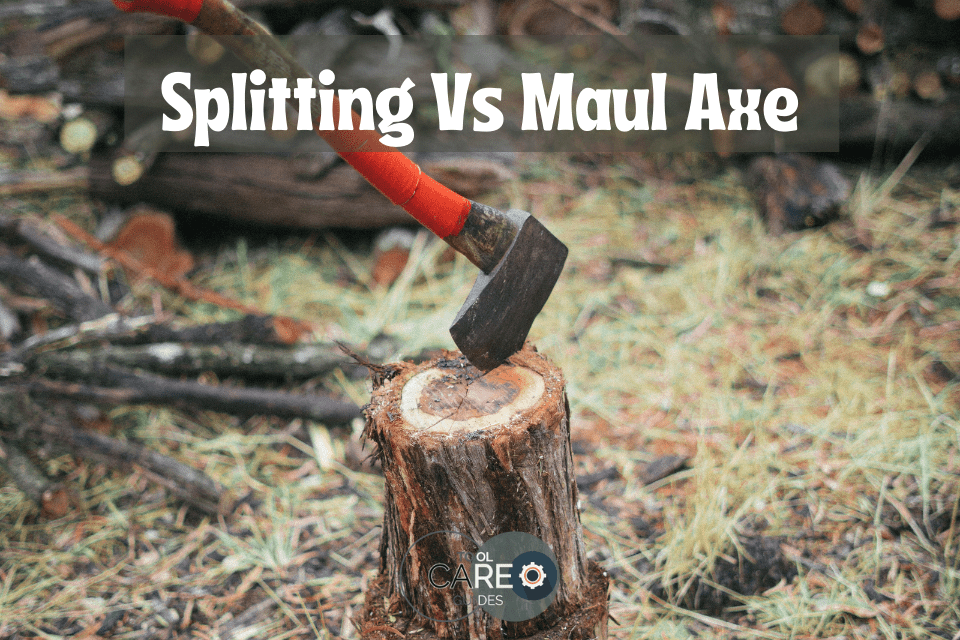Quick Overview of This Article
Splitting wood requires either a splitting axe or a maul axe to complete the job perfectly, but which one is more suitable?
Differentiate between a splitting axe and a maul axe to make your work effortless!
The major difference between the Splitting and Maul Axe is the weight and shape.
Both axes are specific to cutting, felling, splitting, and shaping wood. If you need firewood to prepare for the winter season ahead, you will require a perfect tool to work on your firewood.
A maul axe is wedged and has a metal head thicker than its relative, the splitting axe. On the other hand, it is a narrow metal-headed toll that breaks wood apart along fibers.
Both axes are almost similar, but you don’t have to panic if you cannot single out the differences. You have us here, giving you the similarities as well as the differences.
We will explain you which axe is suitable for splitting your firewood, benefits and detriments of each one of these axes. Read on to buy the most suitable tool splitting axe and splitting maul for working on your firewood.
What Is A Splitting Axe?
A splitting axe is a tool whose unique design includes splitting wood. The axe has a tapered head that wedges deep into the wood, breaking the fibers apart but not cutting them. The splitting axe head weighs between three and six pounds.
The axe works by positioning the the wood on a flat and solid surface. You set the target wood, called a “round,” in a standing position on one of its ends.
The round has to be as close to perpendicular as possible for the perfect and even splitting. There are two steps involved in splitting wood using this axe;
Step one: Gripping the handle of the axe with both hands and raising the axe overhead.
Step two: Striking down the round on the top end.
When you strike the top end of the round, the axe wedge penetrates so that it begins to split the wood. The narrow wedge is specially coated to prevent sticking in the round.
But in case the above mishap happens, you have to remove the wedge carefully as the tool remains one of the most dangerous in woodwork. Be patient with the strikes. After several of them, you will split the wood into two.
Let’s proceed with the critical features of this important and magnificent tool in firewood chopping.
Key Features of a Splitting Axe
Besides the breaking of wood fibers apart, a splitting axe has several key features;
- Tapered head
The splitting axe head design is tapered with a very sharp blade. This key feature makes the axe suitable for multi-use. You can split and cut wood too.
- Material composition
A splitting axe has its head made of high-carbon steel, its handle wood or fiberglass, or steel. These materials are the most durable for a splitting tool like an axe.
- Short handle
A splitting axe has a shorter handle than the maul axe. If you are new to wood cutting, a shorter handle allows you to chop and split wood at a go.
- Low friction coating
Splitting axes comprise of a low-friction coating on their blades that reduce friction. This layer reduces sticking in the wood when splitting.
- Light head
The head of a splitting axe is light. The lightweight is a comparison to its sister tool, the maul axe. When the head of an axe is light, you will feel the lightweight distribution on the entire tool.
This attribute of the splitting axe makes it easy to work with the tool for a longer time. Even lighter is a splitting axe with a composite handle. These are lighter than the ones with wooden handles. In addition, they are more longlasting.
- Shock Absorption
Splitting axes have fiberglass, steel, or wooden handles. These materials absorb vibrations when you are working on wood.
Besides reducing the uncomfortable vibrations, they prevent friction on your palms. The feature also prevents an overstrike, which is quite dangerous.
- Multi-Purpose Use
With a splitting axe in your tools store, you have a multifunctional tool that can split and chop wood. You don’t need to buy an extra tool for felling tres, carving stakes and splitting logs. A splitting axe will do them all.
- Weighted Head
The weight on the axe head helps you to gain the momentum to split wood. Although the entire axe is lightweight, the head is heavier than the handle to allow you a higher swinging power.
- Comfortable design
The splitting axe handle is wooden, steel or fiberglass. Any of the above materials provide a tighter grip on your hands. The handle is grip-enhanced to keep you more comfortable and protected. This design also creates enough room for a single strike split.
- Power and speed
A splitting axe comes with a balanced power-to-weight ratio to allow you to work with minimum effort, speed and split your wood effectively.
Why You Should Buy a Splitting Axe
The ultimate reason for buying a splitting axe depends on your task. In most cases, you have to fall a tree, chop, split and carve your firewood. A tool is convenient if you are looking to cut and split small-sized logs, especially for kindling fire. The sharp blade will dig in between the fibers and also help you to cut the small logs. If you are looking to work on large trees, an ideal tool would be a maul axe.
Pros And Cons
A splitting axe is an important tool in woodwork, Have a look on splitting maul pros and cons:
Pros
- Lightweight: A splitting axes is light to lift and swing around. It weighs three to six pounds, which helps woodcutters work for long hours without fatigue.
- Durable: A splitting axe is the most durable tools around. Despite its lightweight, its head and handle have a strong construction. The head is high-carbon steel, while the handle is wooden, metallic (steel) or fiberglass.
- Sharp: The narrow wedge is sharp to split and cut fibers.
- Great ergonimics: A splitting axe is comfortable to use for long hours without sticking in the wood and grinding your hands. Its short handle is easy to work with. This axe is also perfect for beginners, senior citizens, and women as the design allow superior accuracy during strikes.
- Accuracy: a splitting axe is more accurate when it comes to striking, a feature that woodworkers take advantage of to chip wood.
Cons
- Working with a splitting axe requires a lot of effort during the strikes.
The razor-sharp blade cuts through the ground.
- Splitting axe wedges often get stuck in the round, which requires effort to pull off.
- Requires more force to accomplish a split.
- The axe is likely to cause accidents due to the short handle.
What Is A Splitting Maul?
A maul is different from a splitting axe because it comes with a huge sledgehammer and a pointed head. The head is heavy and weighs between six and eight pounds. Compared to the splitting axe, a maul axe handle is longer, and its blade is duller. The axe is not suitable for splitting wood, but it can function by applying force. In general, a maul axe is heavier than a splitting axe.
If you have no energies to swing a maul, you better go for a splitting axe. Veteran woodcutters refer to the axe as blockbusters, block splitters, or sledge axe, among other nicknames. The naming is probably because of the heavyweight.
But the maul axe is an excellent tool if you are working on large logs of wood. It will split along your target’s fibers without wastage. The axe works by delivering sheer force into the target and breaking its fibers.
A notable difference between a maul and a splitting axe is the long handle. The long handle is the tool’s guiding power into the target after a swing.
The maul axe functions the same way as its sister tool, the splitting axe. Here are the two steps;
Step 1: Grip the handle with your two hands and raise the axe overhead.
Step 2: Swing the axe bacj and strike the end of the round for a split. You will swing the axe several times to split the wood faster than you would with a splitting axe.
A major advantage of a maul axe is that it rarely sticks in the round. The weight and size of the wedge will not allow that. It will not even penetrate deeply into the round like the splitting axe, but eventually, its force causes the wood to split.
There are several key features about the maul axe that you can master to avoid confusing the tool with the splitting axe.
Key Features of A Maul Axe
Here are the key features of a maul axe;
- Material and design
A maul axe also called a splitting maul, splits wood. With its steelhead and coned wedge, the maul relies on its heavyweight. The axe applies the weight on the target wood to split it. A maul’s head size is larger, wider, and heavier than a splitting axe. When you swing the axe the weight on its head and the swing’s force drive the wedge into the round, and splits it.
- Blunt wedge
A maul has a blunt wedge. The blunt is a deliberate design to prevent the wedge from getting stuck in the round.
- Weight
A splitting maul is almost double the weight of a splitting axe. The weight is 6 – 8lbs vs. the splitting axe’s 3 – 6 lbs. Although the maul is heavyweight and difficult to handle, it is quite efficient in splitting wood.
- Handle
The maul’s axe is longer when you compare it to the splitting axe handle. It would be senseless to have a heavy head and a short axe. Lifting and striking would be a challenge.
The long handle makes it easy for the tool to find its way to the round. Its heavyweight pulls the tool away from your feet.
We can’t overlook the maul’s handle material. Most mauls have a steel or fiberglass material.
Some handles are made of hardwood, but the material break within a short time due to the head’s weight. Although wooden handles offer flexibility and a good grip, fixing your maul with a metallic handle for safety and durability is better.
- Head
The head design is a notable feature that makes the most significant difference between a maul and a splitting axe. A maul’s head is broader and larger than a splitting axe head.
In addition, the head comprises high-grade carbon steel, 45-60 Rockwell grade. That gives the tool high endurance even if it strikes a rock. The weight ranges from eight to twelve pounds and is V-shaped.
The maul’s blade is not sharp and tapered like its sister axe. Cutting with a maul is easy but requires extra muscles and strength to do the job.
- Maul Head Eye
Still on the head is the poll end. This one functions like a sledgehammer. You can combine it with the wedge to split the toughest wood. Also, there is a feature known as an eye. It is either a sledge axe-head eye or a sledge-head eye. The handle fits on both eyes perfectly.
- Strength and Durability
The strength of a maul is on its head and handle. A maul’s head is heat-treated and forged from carbon steel for perfect strength and durability. When you fix the handle, it securely matches the head to offer stability and safety. The metal handles come welded on the axe head.
Why You Should Buy a Maul Axe
Interestingly, a maul axe will be a great choice for splitting wood than any other type of ace, including the splitting axe.
If you wonder how that is possible, have a look: A maul’s blunt wedge-shaped head strikes and cleave through the round tearing its fibers apart perpendicularly.
In most cases, a single or double strike is enough to leave your target in splits, the axe’s wedge is blunt, but it drives into the wood with momentum. It does not get stuck because of its shape, weight, and size.
Choosing a maul axe for your firewood work means applying less effort at work. Besides, the axes are great for workouts. You don’t need to pay for gym services if you have a maul axe around. But if you are a senior citizen or weak in stature, this not be a great choice for your winter firewood. In that case, get a splitting axe, light enough to measure up with your strength.
Axe Versus Splitting Maul Pros And Cons
Like the splitting axe, the maul axe comes with its strengths and weaknesses. Have a glance;
Pros
- The axe splits rounds effectively.
- The axe does not stick in the round.
- A maul has excellent leverage.
- It works with a higher velocity.
- The maul’s blade doesn’t require regular sharpening.
Cons
- The heavy wedge is difficult to swing and tires you easily.
- Less accurate strikes.
- Blunt.
What Are The Main Differences Between The Splitting Axe And Maul?
| Features | Splitting Axe | Splitting Maul |
| Weight | Lightweight, 3 to 6 lbs | Heavy, 6 to 8 lbs |
| Head Design | Sharp, features a tapered cutting edge, a blade, and an eye portion | Fat, blunt, hammer-like wedge or semi-wedge shaped |
| Handle Structure | Short, no longer than an arm’s length, wood or composite handles | Very long, made from fiberglass, metal, wood, or plastic |
| Usage | Multi-purpose, used for chopping, splitting, shaping, etc | Only suitable for splitting wood with precision |
We will look at the features to get the idea between the Splitting Vs Maul Axe. Although the two axes have many similarities, you will find several features that can help you make the right decisions.
Find out the differences below;
1. Head
- Weight: the weight of these two axes differ. A maul’s head weighs between six and eight pounds. Some mauls weigh as high as twelve pounds, while the splitting axe weighs three and six pounds.
- Shape: The axes have a wedgy head, but when you keenly observe both, the maul is broad, while the splitting axe is narrower.
- Size: A maul’s head is larger than a splitting axe.
- Weight: Both axes are made of steel, meaning the maul’s head, which is bigger, is also heavier.
- Sharpness: A splitting axe is sharper than a maul but also requires regular sharpening.
- Accuracy: When it comes to precision, the splitting axe wins. The maul is less accurate because of its blunt nature.
- Leverage: A splitting axe has lesser power than a maul.
2. Handle
Length: The maul’s handle length is longer than that of the splitting axe. The reason is the head weight. Working with a heavy maul’s head and a short handle will be a dangerous affair bearing in mind that you work towards your leg. The splitting axe requires a short handle because it is lightweight.
Material: a splitting axe material can range from wood, steel to fiberglass or composite. But the best material for a maul is metal. Some mauls have hardwood and fiberglass material, but the metal handle works better. Metallic handles endure heavyweight and do not break easily.
Maul Or Axe For Splitting Wood??
When it comes to the right axe for firewood, we will narrow it down to preference. The two axes are perfect for splitting wood. But you will base your choice on strength, weight, stamina, size, price, maintenance, versatility, and the task at hand. The above comparisons of splitting Axe vs splitting Maul should help you find the best axe for you.




